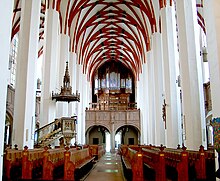Loading AI tools
From Wikipedia, the free encyclopedia
Gelobet sei der Herr, mein Gott (Praised be the Lord, my God),[1] BWV 129, is a church cantata by Johann Sebastian Bach. It is a chorale cantata performed on Trinity Sunday 8 June 1727 in Leipzig.[2] Rediscovery of the printed libretto of the cantata in the first decade of the 21st century led to a re-appraisal of prior assumptions regarding the early performance chronology of a few cantatas, including this one.[3]
| Gelobet sei der Herr, mein Gott | |
|---|---|
BWV 129 | |
| Chorale cantata by J. S. Bach | |
 Thomaskirche, Leipzig | |
| Occasion | Trinity Sunday |
| Chorale | "Gelobet sei der Herr, mein Gott" by Johann Olearius |
| Performed | 8 June 1727: Leipzig |
| Movements | 5 |
| Vocal |
|
| Instrumental |
|
The text of the cantata is a general praise of the Trinity, without a reference to a specific gospel reading. Addressing God the Creator, the Saviour and the Comforter, it could be used for other occasions such as Reformation Day. The cantata is festively scored and ends in a chorale fantasia, like the Christmas Oratorio.
The cantata was apparently composed for Trinity Sunday. Originally it was thought the cantata may have been performed as early as 16 June 1726.[4] In his second year Bach had composed chorale cantatas between the first Sunday after Trinity of 1724 and Palm Sunday 1725, but for Easter that year he had returned to cantatas on more varied texts, possibly because he lost his librettist.[5] Later Bach composed again chorale cantatas which may have been intended to complete his second annual cycle. This cantata was possibly one of such completing works. Rediscovery of the printed libretto of the cantata in the first decade of the 21st century led to a re-appraisal of prior assumptions regarding the first performance of this cantata: it was performed on Trinity Sunday 8 June 1727.[3][2] The cantata may also have been performed on Reformation Day.[6]
The cantata is based entirely on the unchanged words on the hymn Gelobet sei der Herr, mein Gott (1665) by Johann Olearius and celebrates the Trinity in five stanzas.[4][7] The prescribed readings for Trinity Sunday were from the Epistle to the Romans, reflecting "depth of wisdom" (Romans 11:33–36), and from the Gospel of John, the meeting of Jesus and Nicodemus (John 3:1–15). Unlike most chorale cantatas of 1724/25, but similar to the early Christ lag in Todes Banden, BWV 4, and Lobe den Herren, den mächtigen König der Ehren, BWV 137, also composed after the second cantata cycle, Bach left the chorale text unchanged, thus without a reference to the readings.[4][8]
The cantata in five movements is festively scored for three soloists, soprano, alto and bass, a four-part choir, three trumpets, timpani, flauto traverso, two oboes, oboe d'amore, two violins, viola, and basso continuo.[4]
The opening chorus on the first stanza of the chorale begins with a concerto of all the instruments as a ritornello. The trumpets highlight occasionally the interplay of strings and woodwinds. The cantus firmus, a melody of O Gott, du frommer Gott by Ahasverus Fritsch (1679), [9] is sung by the soprano, while the other voices sing sometimes in imitation, sometimes in homophony. The text is a praise of the God the Creator.
The following three movements are all arias. In the first aria the bass praises God the Saviour, accompanied only by the continuo. Bach may have thought of the vox Christi (voice of Christ), and of his humility. The word "Gelobet" (praised) is set as an expressive melisma. In the second aria the soprano, accompanied by flute and violin, praises God the Comforter. In the third aria the alto is accompanied by an oboe d'amore in song-like general praise. John Eliot Gardiner suggests that the "pastoral dance" was "inspired, perhaps in its imagery, by the concept of "den alles lobet, was in allen Lüften schwebet" (praised by all things that move in the air).[1][8] The final chorale is set in a joyful concerto of the instruments, similar to the conclusions of Bach's Christmas Oratorio and Ascension Oratorio.[4] Gardiner calls it "punctuated by brass and orchestral fanfares."[8] By this festive ending Bach marked Trinity Sunday as the conclusion of the first part of the liturgical year.
Seamless Wikipedia browsing. On steroids.
Every time you click a link to Wikipedia, Wiktionary or Wikiquote in your browser's search results, it will show the modern Wikiwand interface.
Wikiwand extension is a five stars, simple, with minimum permission required to keep your browsing private, safe and transparent.